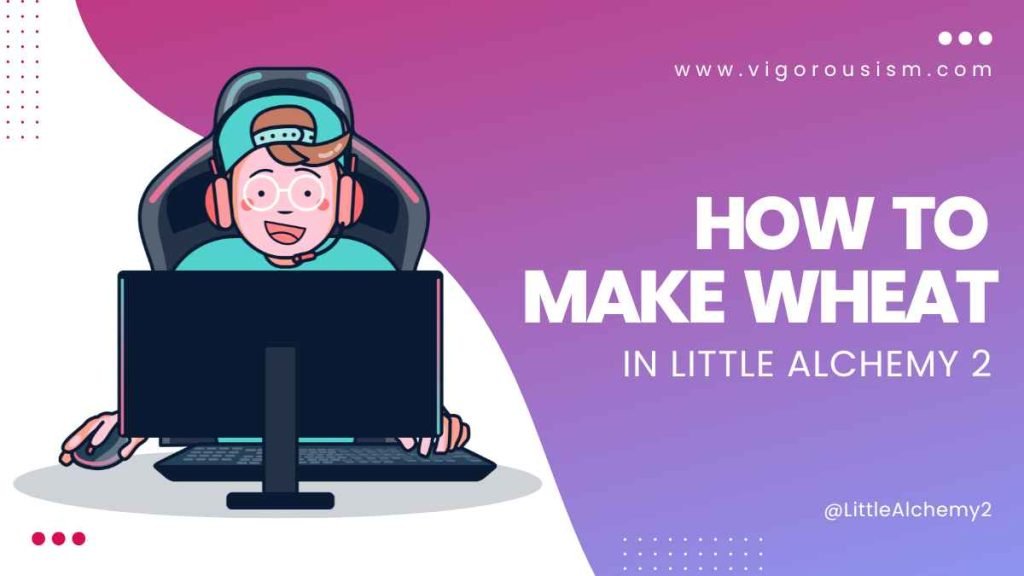How to Make Wheat in Little Alchemy 2! In the whimsical universe of Little Alchemy 2, where imagination knows no bounds, creating the elemental essence of wheat can be both fascinating and rewarding. If you’re eager to cultivate this fundamental ingredient within the game, you’ve come to the right place. In this comprehensive guide, we’ll take you through the process of How to Make Wheat in Little Alchemy 2. Let’s dive right into the world of wheat in Little Alchemy 2!
Table of Contents
Introduction: Sowing the Seeds of Knowledge
Before we embark on our journey to create wheat in Little Alchemy 2, let’s take a moment to appreciate the charm of this virtual alchemical playground. It’s a world where the fusion of elements unlocks endless possibilities, and crafting wheat is just one example of the magical concoctions that await you.
How to Make Wheat in Little Alchemy 2
Creating wheat within the game is a simple yet essential process. To do so, follow these steps:
Total Time: 3 minutes
Start with Soil
Lay the foundation for your wheat by combining earth and earth, resulting in soil.
Plant the Seed
Next, introduce the concept of life by adding a seed to the soil. This vital step is the essence of growing wheat.
Nurture with Time
Patience is key. Allow time for the seed to sprout and grow into a healthy wheat plant.
Harvest the Wheat
Once the plant matures, you’ll be rewarded with a bountiful harvest of wheat, a fundamental element in the game.
The Fastest Way to Create Wheat
For those eager alchemists who can’t wait to reap the benefits of wheat, here’s a pro tip: Use the “time” element. Simply add “time” to your soil and seed, and watch as your wheat grows almost instantly. This shortcut is perfect for those moments when you’re in a hurry to complete your alchemical recipes.

Common Mistakes to Avoid
Creating wheat in Little Alchemy 2 is usually a breeze, but it’s not without its challenges. Here are some common mistakes to steer clear of:
- Incorrect Ingredients: Ensure you’re using soil and a seed to create wheat. Using the wrong elements will result in failure.
- Impatience: Rushing the growth process may lead to underdeveloped wheat. Be patient and allow it to mature fully.
Uses of Wheat in the Game
Wheat is a versatile element in Little Alchemy 2. Once you’ve created it, you can use it to craft various other items, such as:
- Bread: Combine wheat with the “fire” element to bake a delicious loaf of bread.
- Flour: Wheat is a primary ingredient for creating flour, which is used in many recipes.
- Farm: Combine wheat with the “field” element to establish your very own virtual farm.
Advantages and Disadvantages of Wheat in the Game
Advantages:
- Versatility: Wheat serves as a cornerstone for numerous alchemical recipes, allowing you to explore a wide range of possibilities.
- Speedy Creation: Using the “time” element expedites wheat production, making it a convenient choice for your alchemical experiments.
Disadvantages:
- Dependency on Ingredients: Creating wheat relies on specific elements (soil and a seed), so you must have them available.
Tips and Tricks for Wheat Crafting
Mastering the art of wheat-making requires finesse. Here are some tips and tricks to enhance your alchemical skills:
- Experiment: Don’t hesitate to experiment with different combinations of elements. You might stumble upon unique recipes.
- Use Hints: If you’re stuck, Little Alchemy 2 offers hints to guide you in the right direction. Don’t hesitate to use them when needed.
- Stay Organized: Keep track of your progress and the elements you’ve already created. This will help you avoid redundancy and streamline your alchemical adventures.
Facts About Wheat in the Game
- Wheat is one of the most frequently crafted elements in Little Alchemy 2, owing to its essential role in various recipes and quests.
- It often plays a pivotal part in challenges and missions within the game, making it a valuable asset for advancing and completing tasks.
Conclusion: Reaping the Rewards of Wheat
In conclusion of How to Make Wheat in Little Alchemy 2, crafting wheat is both rewarding and versatile. By following the simple steps outlined in this guide, you can create wheat with ease, explore its myriad uses, and discover its advantages and disadvantages. Remember, the key to success in Little Alchemy 2 lies in experimentation and creativity. So, go ahead, cultivate some wheat, and embark on your alchemical journey in this fascinating universe. Here you can check more Little Alchemy 2 guides like How to Make a Telescope in Little Alchemy 2, and How to Make River in Little Alchemy 2.
FAQs About How to Make Wheat in Little Alchemy 2
Can I create wheat without using the “time” element for faster results?
Yes, you can create wheat without using “time,” but it will take longer. Simply combine soil and a seed to grow wheat naturally.
What other elements can I craft by using wheat in the game?
Wheat is a versatile ingredient that can be used to create various items, including bread, flour, and even a farm.
Is there a limit to the number of wheat elements I can create in the game?
There’s no set limit to how many wheat elements you can create. Feel free to craft as much as you need for your alchemical adventures.
Can I use wheat in combination with other elements to discover unique recipes?
Absolutely! Experimenting with wheat and other elements can lead to exciting discoveries and new recipes.
Are there any quests or challenges in the game where wheat is particularly useful?
Wheat often plays a pivotal role in quests and challenges, making it essential for progressing in the game.
Can I create different types of wheat, like whole wheat or rye, in the game?
In Little Alchemy 2, you create a generic wheat element. The game doesn’t differentiate between specific types of wheat.
Is there any secret recipe involving wheat that I should be aware of?
While there are no secret recipes, there are many creative combinations involving wheat waiting to be discovered. Keep experimenting!


